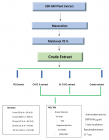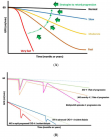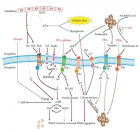Table of Contents
Convalescent plasma therapy in aHUS patient with SARS-CoV-2 infection
Published on: 22nd April, 2022
OCLC Number/Unique Identifier: 9485831799
Endotheliosis, thrombotic microangiopathy and complement system over activation have been described as pathologic features of tissue damage in the setting of coronavirus disease. Interestingly, complement-mediated cell injury is also a typical feature of atypical Hemolytic Uremic Syndrome. Indeed, a growing body of literature has described a higher risk of microangiopathy recurrence, in aHUS patients who test positive for SARS-CoV-2. The correct clinical and therapeutic management patients with a history of HUS and SARS-CoV-2 infection is not well established.We report a case of SARS-CoV-2 infection in an aHUS patient who did not develop a recurrence of the disease and that was successfully treated with convalescent immune plasma therapy.
Assessment of knowledge of acute kidney injury among non-nephrology healthcare workers in North-Kivu Province, Democratic Republic of the Congo
Published on: 6th April, 2022
OCLC Number/Unique Identifier: 9470693131
Background: Assessment of knowledge of acute kidney injury (AKI) among healthcare workers (HCWs) is necessary to identify areas of deficiency and key topics to focus on while organizing educational programs to improve AKI care. The objective of this study was to assess AKI knowledge and practice among health care providers in North Kivu province, the eastern Democratic Republic of the Congo. Material and methods: This was a cross-sectional study conducted in six public hospitals in North Kivu province using a self-administered questionnaire. Results: A total of 158 HCWs completed the survey, among them 66 (41.78%) were physicians. The mean age of respondents was 36.07 ± 10.16 years and the male gender was 56.33%. Only 12 (7.59%) of the respondents had a good knowledge of the definition and classification of AKI. The respondents’ mean scores were 6.76 out of a total of 18 about risk factors for AKI and 6.29 out of a total of 11 with regard to nephrotoxic drugs. Regarding practices, 28.48% of the respondents assess the risk of AKI in their patients in their daily practices; 31.65% report AKI in the patients’ medical history, and 33.54% call on a nephrologist specialist to get specialized advice. Conclusion: This study found considerable gaps in knowledge and practice regarding AKI among most of HCWs in North Kivu province.
Community-acquired AKI and its management
Published on: 17th March, 2022
OCLC Number/Unique Identifier: 9486957608
Acute Kidney Injury (AKI) is defined as an abrupt decrease in kidney function within hours to days and is caused by multiple factors. Community-acquired AKI (CA-AKI) is common in developing countries, and it is crucial to bring awareness about its epidemiology and simple preventive strategies that can tackle this potentially serious complication. Infections, use of over-the-counter medicines, traditional herbal remedies, animal (and insect) bites, and pregnancy-related complications are common causes of CA-AKI in developing countries. The incidence of vector-borne disease-related AKI and obstetric causes of AKI have decreased following better public health policies in most developing countries. Appropriate fluid management is critical in AKI, both in terms of prevention of development and progression of AKI. Timely initiation and de-escalation of fluid therapy are both equally important. Kidney replacement therapy (KRT) is indicated when AKI progresses to stage 3 and/or patients develop refractory fluid overload or electrolyte imbalances and/or uremic complications. Hemodialysis is the most common modality of KRT in adults, whereas peritoneal dialysis is the dominant modality in small children. Convective renal replacement therapy, such as hemofiltration, is increasingly used in critically sick patients with AKI and hemodynamic instability. To summarize, CA-AKI is a common, serious, and often preventable complication of certain conditions acquired in the community, and is, therefore, a matter of utmost concern from the public health perspective.
Time within therapeutic range: A comparison of three tacrolimus formulations in renal transplant recipients
Published on: 1st February, 2022
OCLC Number/Unique Identifier: 9415692649
Background: Currently there are three available formulations of tacrolimus in the United States; these include immediate-release capsules (TAC-IR), extended-release capsules (TAC-XL),and extended-release tablets (TAC-XR). Previous studies have demonstrated non-inferiority between the three formulations in terms of efficacy. The purpose of this study was to compare three formulations of tacrolimus (TAC) and assess differences in time within the therapeutic range (TTR) and variability in levels. Results: Renal transplant recipients from January 2013 to October 2017 were retrospectively identified for analysis. Deviation from standard TAC protocol or formulation changes excluded patients. The primary outcome compared percent TTR (TTR %) among 3 TAC formulations over the first 90 days post-transplant. TTR was calculated using the Rosendaal method. Secondary outcomes included differences in TAC levels, TAC dose, eGFR, rejection, patient and graft survival between the TAC formulations. TAC-XR demonstrated a significantly higher TTR % compared to TAC-IR and TAC-XL (62.8% vs. 53.3% vs. 60.9%, p = 0.048). In post-hoc analysis, TAC-XR had a higher TTR % compared to TAC-IR (p = 0.065), which approached statistical significance. Average TAC levels, weight-normalized TAC doses, median dose-normalized TAC levels, rejection rates, eGFR, and graft or patient survival were similar among groups. Conclusion: In the early transplant period, TTR was significantly different among the groups. TAC-XR demonstrated numerically superior time within the therapeutic range. Patient-specific factors such as race, obesity, genetic polymorphisms may impact this variability and clinical outcomes. Further analysis is necessary to understand the effect of each patient-specific factor on TAC exposure.
An update in the utilization of N-acetyl cysteine & vitamin c for tackling the oxidative stress in acute kidney injury secondary to robust sepsis - A systematic review
Published on: 1st February, 2022
OCLC Number/Unique Identifier: 9414669659
The commonest etiology of acute kidney injury (AKI) is Sepsis that results in an escalation of morbidity and mortality in the hospital intensive care units. Existentially, the therapy of septic AKI rather than being definitive or curative is just supportive, without tackling the pathophysiology. Usually, Sepsis gets correlated with systemic inflammation, along with the escalated generation of Reactive oxygen species (ROS), in particular superoxide. Simultaneously liberation of nitric oxide (NO) subsequently reacts with the superoxide, thus, resulting in the generation of reactive nitrogen species (RNS), that is mostly peroxynitrite. This sepsis stimulated generation of ROS in addition to RNS might cause a reduction in the bioavailability of NO that modulates microcirculation aberrations, localized tissue hypoxia as well as mitochondrial impairment, thus starting a vicious cycle of cellular damage which results in AKI. Here we conducted a systematic review utilizing search engine PubMed, Google scholar; Web of science; Embase; Cochrane review library utilizing the MeSH terms like septic AKI; ROS; inducible nitric oxide synthase (iNOS); nicotinamide adenine nucleotide phosphate(NADPH)oxidase complex; Oxidative stress; Renal medullary hypoxia; Hypoxia inducible factor1; hypoxia responsive enhancer A; mitochondrial impairment; Intrarenal oxygenation; urinary oxygenation; erythropoietin gene; RRT; NAC; Vitamin C from 1950 to 2021 till date. We found a total of 6500 articles out of which we selected 110 articles for this review. No meta-analysis was done. Thus here we detail the different sources of ROS, at the tie of sepsis, besides their pathophysiological crosstalk with the immune system, microcirculation as well as mitochondria that can result in the generation of AKI. Furthermore, we detail the therapeutic utility of N-acetylcysteine (NAC), besides the reasons for its success in ovine as well as porcine models of AKI. Moreover, we discuss preclinical along with clinical for evaluation of Vitamin C’s antioxidant effects as well as pleiotropic effects as a stress hormone that might aid in abrogation of septic AKI.

HSPI: We're glad you're here. Please click "create a new Query" if you are a new visitor to our website and need further information from us.
If you are already a member of our network and need to keep track of any developments regarding a question you have already submitted, click "take me to my Query."


























































































































































